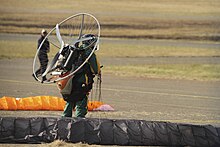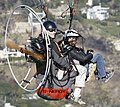Powered paragliding
This article needs additional citations for verification. (September 2009) |


Powered paragliding, also known as paramotoring, is a form of ultralight aviation where the pilot wears a motor on his back (a paramotor) which provides enough thrust to take off using an adapted paraglider or paramotor wing. It can be launched in still air, and on level ground, by the pilot alone — no assistance is required.
In many countries, including the United States, powered paragliding is minimally regulated and requires no license. The ability to fly both low and slow safely, the 'open' feel, the minimal equipment and maintenance costs, and the portability are claimed to be this type of flying's greatest merits.[1]
Powered paragliders usually fly between 15 and 45 mph (25 and 70 km/h) at altitudes from 'foot-dragging in the grass' up to 18,000 ft (5400 m) although most flying is done under 500 ft (150 m) AGL (above ground level).[2] Due to the paramotor's slow forward speed, it must not be flown in conditions of high wind, turbulence, or intense thermal activity.
The paramotor, weighing from 45 to 80 pounds (20 to 36 kg) is supported by the pilot during takeoff. After a brief run (typically 10 feet or 3 metres) the wing lifts the motor and its harnessed pilot off the ground. After takeoff, the pilot gets into the seat and sits suspended beneath the inflated paraglider wing. Control is available using brake toggles for roll and a hand-held throttle for pitch.
Prices for a complete new package (wing, harness, and motor) vary from approximately $6000 USD to $9500 USD.
Uses
Military
In some armies, powered paragliding is used to insert special forces soldiers into specific areas. The Lebanese Airborne regiment adopted this technique in 2008.
Civilian
Powered paragliders are useful as replacements to terrestrial vehicles in difficult terrain. In the spring, when the sea or lakes are still frozen, but the ice has begun melting, they cannot be walked, skied, or driven on, and cannot be navigated by boat. Hydrocopters, hovercraft, and aircraft are the only ways to travel in such conditions. Furthermore, if the landscape is fractured by small and shallow lakes and bays, as in swamplands, it may be difficult to navigate even in good conditions. Observation and counting of protected species, e.g. Saimaa ringed seal, in such conditions has been conducted using a powered paraglider.
Another use that has been demonstrated is the herding of reindeer. Although the tundra is open terrain, there are no roads and the terrain is still uneven. A powered parachute can be used instead of a snowmobile or a motorcycle.
Safety and regulations
Research done by FootFlyer.com estimates that the activity is slightly safer (per event) than riding motorcycles and more dangerous than riding in cars.[3] The most likely cause of serious injury is body contact with a spinning propeller. The next most likely cause of injury is flying into something other than the landing zone. Some pilots carry a reserve parachute designed to open in as little as 50 ft (15 m). The most likely cause of fatality is drowning.
The lack of established design criteria for these aircraft led the British Air Accidents Investigation Branch to conclude in 2007 that "Only when precise reserve factors have been established for individual harness/wing combinations carrying realistic suspended masses, at load factors appropriate to the manoeuvres to be carried out, can these aircraft be considered to be structurally safe"[4]
License and training
Neither a license nor specific training is required in the U.S., U.K. or many other countries. Where there is no specific regulation (e.g. Mexico), paramotor flying is tolerated provided the pilots cooperate with local officials when appropriate.[citation needed] In countries where specific regulation exists, such as Canada, France, Italy, and South Africa, pilots must be trained, both in flying theory and practice, by licensed instructors. Some countries that require formal certification frequently do so through non-government ultralight aviation organizations.
Regardless of regulations, powered paragliding can be dangerous when practiced without proper training.
For a pilot to get through most organizations' full pilot syllabus requires around four weeks. A number of techniques are employed for teaching, although most include getting the student familiar with handling the wing either on the ground, small hills, or on tandem flights.
With special gear it is possible to take a passenger (tandem), but most countries, including the U.S., require some form of certification to do so.
Regulations
In most countries, paramotor pilots operate under simple rules that spare them certification requirements for pilot and gear. Those laws, however, limit where they can fly—specifying that pilots remain in sparsely populated areas where risk to other people or aircraft is limited. U.S. pilots operate under Federal Aviation Administration regulation Part 103.
Associations
In the USA, the sport is represented primarily by the US Powered Paragliding Association (USPPA)[note 1] which also holds an exemption allowing two-place training using foot-launched paramotors. The US Ultralight Association (USUA) and ASC also offer some support.
In Britain the sport is officially represented by the British Hang Gliding and Paragliding Association[5] and unofficially by the Paramotor Club.[6]
Trikes and powered parachutes

Lightweight carts or "trikes" (called "quads" if they have four wheels) can also be mounted on powered paragliders for those who prefer not to, or are unable to, foot launch. Some are permanent units.
In some countries, such as the UK, the legal position of trikes is unclear. In the United States, if the aircraft meets the ultralight definitions, no license is required. The same is true in the UK under SSDR rules (Single Seat De-Regulated). However, even in these countries, if the machine has two seats it is no longer an ultralight. In the US such a craft would be governed under the Sport Pilot rules and regulated as a light sport aircraft powered parachute which requires an aircraft N-number and pilots must be licensed.
A powered paraglider differs from a powered parachute (PPC) primarily in size, power, control method, and number of occupants. Powered paragliders are smaller, use more efficient (but more difficult to manage) paraglider wings, and steer with brake toggles like sport parachutists. Powered parachutes typically use easier-to-manage but less efficient wings, have larger engines, steer with their feet, and may be able to take along passengers. There are exceptions; a growing number of powered parachutes use elliptical wings, some use hand controls, and many are light single seat aircraft that meet FAA Part 103 requirements.
World records
Determined by the FAI, RPF1 category.[7]
- The current world altitude record for powered paragliders (RPF1) is 6,102m (20,019 ft). It was set by Ramon Morillas Salmeron (Granada, Spain) on 06/10/2006 while flying an Advance Omega 7 paraglider and a PAP 1400 Ross power unit.
- A highly publicized altitude record attempt was made by Bear Grylls on 14 May 2007 at 0933 local time over the Himalayas using a parajet engine invented by Gilo Cardozo and a specifically designed Reflex paraglider wing invented by Mike Campbell-Jones of Paramania. Gilo, who also flew in the attempt, had engine problems that ended his climb 300m short of the record. Bear went on to claim an altitude of 8,990m (29,494 ft), though satisfactory evidence of this claim was not submitted to FAI, and therefore it was not ratified as a world record for this aircraft class.[8]
- Distance in a straight line without landing : 1,105 km (687 mi) set on 23/04/2007 by Ramon Morillas Salmeron flying from Jerez de la Frontera, Cádiz (Spain) to Lanzarote, Canary Islands (Spain) with an Advance Omega 7 paraglider.
Determined by Guinness World Records [9]
- Longest Journey by Powered Paraglider : 8,008 km (4,976 mi) set on 24 August 2009 [10] by Canadian photographer and documentary filmmaker Benjamin Jordan during his Above + Beyond Canada campaign. In an unprecedented flight between Tofino, BC and Bay Saint Lawrence, NS, the cross-Canada campaign involved 108 flights with landings at schools and youth summer camps along the way. Jordan provided youth with motivational speeches and arranged them in shapes on the ground before launching and continuing on the next leg of his journey. Funds raised over the course of the trip were donated to various charities across Canada to help children from low-income homes attend summer camp. Year's later, Jordan's photography, books and DVD's published as a result of this journey are still raising funds for this cause.
Images
-
Launch of a powered paraglider
-
A powered paraglider in flight
-
A tandem powered paraglider
-
powered paraglider landing
See also
- Paramotor
- Hang gliding
- Powered hang glider
- Powered parachute
- Powered skydiving, where the man jumps out of an aircraft
- Kite
- Ultralight trike
- Eggmotor Project A website dedicated to Do-It-Yourself 4 stroke paramotor projects.
References
This article includes a list of general references, but it lacks sufficient corresponding inline citations. (September 2009) |
- Notes
- Citations
- ^ Goin, Jeff (2006). Dennis Pagen (ed.). The Powered Paragliding Bible. Airhead Creations. ISBN 0-9770966-0-2.
- ^ "Paramotoring Questions Answered". U.S. Powered Paragliding Association. 2006-07-27. Retrieved 2007-01-24.
- ^ Jeff Goin [1] March, 2012
- ^ UK Air Accidents Investigation Branch "Bulletin S4/2007 Special", August 2007
- ^ "British Hang Gliding and Paragliding Association". Bhpa.co.uk. Retrieved 2011-10-12.
- ^ "Paramotor Club". paramotorclub.org. Retrieved 2011-10-12.
- ^ "Microlights World Records". Fédération Aéronautique Internationale, FAI. Retrieved 1 April 2012.
- ^ "Flying over the top of the world". BBC News. 2007-05-17. Retrieved 2010-05-22.
- ^ "Microlights World Records". Guinness World Records. Retrieved 1 January 2013.
- ^ "Guinness Word Records : Longest Journey by Powered Paraglider". Guinness Word Records, UK. Retrieved 1 January 2013.
External links
- Learn PPG - Powered Paragliding Tutorial
- USPPA - United States Powered Paragliding Association
- PPG Videos - Powered Paragliding Videos
- E-PAC - electric paraglider




